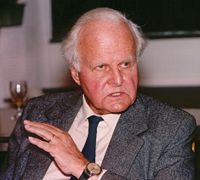| Carl Friedrich von Weizsäcker | |
|---|---|
| Nascimento | 28 de junho de 1912[[Categoria:Predefinição:Categorizar-ano-século-milénio/1]] Quiel |
| Morte | 28 de abril de 2007 (94 anos)[[Categoria:Predefinição:Categorizar-ano-século-milénio/1]] Starnberg |
| Nacionalidade | alemão |
| Prêmios | Medalha Max Planck (1957), Prêmio Goethe (1958), Prêmio Templeton (1989) |
| Orientador(es) | Werner Heisenberg e Friedrich Hund[1] |
| Campo(s) | física, filosofia |
| Tese | 1933: Durchgang schneller Korpuskularstrahlen durch ein Ferromagnetikum |
Carl Friedrich von Weizsäcker (Quiel, 28 de junho de 1912 — Starnberg, 28 de abril de 2007) foi um físico e filósofo alemão.[2] Foi membro do grupo Os Dezoito de Göttingen, que se manifestou em 1957 contra o armamentismo atômico da Alemanha Ocidental.
Carreira
Ele foi o membro mais longevo da equipe que realizou pesquisas nucleares na Alemanha durante a Segunda Guerra Mundial, sob a liderança de Werner Heisenberg. Há um debate em andamento sobre se ele e os outros membros da equipe buscaram ativa e voluntariamente o desenvolvimento de uma bomba nuclear para a Alemanha durante esse período.[3][4][5]
Weizsäcker fez importantes descobertas teóricas sobre a produção de energia em estrelas a partir de processos de fusão nuclear.[6][7][8] Ele também fez um trabalho teórico influente sobre a formação planetária no início do Sistema Solar.[9]
No final de sua carreira, ele se concentrou mais em questões filosóficas e éticas, e recebeu várias honras internacionais por seu trabalho nessas áreas.
Família
Membro da proeminente família Weizsäcker, era filho do diplomata Ernst von Weizsäcker, irmão mais velho do ex-presidente alemão Richard von Weizsäcker, pai do físico e pesquisador ambiental Ernst Ulrich von Weizsäcker e sogro do ex-general Secretário do Conselho Mundial de Igrejas Konrad Raiser.
Trabalhos
- Zum Weltbild der Physik, Leipzig 1946 (ISBN 3-7776-1209-X), 2002, 14ª edição, renovada e com introdução por de:Holger Lyre
- tradução para o inglês por Marjorie Grene The World View of Physics, Londres, 1952
- tradução para o francês Le Monde vu par la Physique, Paris 1956
- Die Geschichte der Natur, Göttingen 1948 (ISBN 3-7776-1398-3)
- Die Einheit der Natur, Munich 1971 (ISBN 3-423-33083-X)
- tradução The Unity of Nature, Nova York, 1980 (ISBN 0-374-28100-9)
- Wege in der Gefahr, Munich 1976
- tradução The Politics of Peril, Nova York 1978
- Der Garten des Menschlichen, Munich 1977 (ISBN 3-446-12423-3)
- tradução The Ambivalence of progress, essays on historical anthropology, Nova York 1988 (ISBN 0-913729-92-2)
- Deutlichkeit: Beiträge zu politischen und religiösen Gegenwartsfragen, Hanser, München, 1978, 1979 (ISBN 3-446-12623-6).
- The Biological Basis of Religion and Genius, Gopi Krishna, Nova York, introdução. por Carl Friedrich von Weizsäcker, que é metade do livro, 1971, 1972 (ISBN 0-06-064788-4)
- Aufbau der Physik, Munich 1985 (ISBN 3-446-14142-1)
- tradução The Structure of Physics, Heidelberg 2006 (ISBN 1-4020-5234-0; ISBN 978-1-4020-5234-7)
- Der Mensch in seiner Geschichte, Munich 1991 (ISBN 3-446-16361-1)
- Zeit und Wissen, Munich 1992 (ISBN 3-446-16367-0)
- Der bedrohte Friede, 1994 (ISBN 3-446-13454-9)
- Große Physiker, Munich 1999 (ISBN 3-446-18772-3)
Referências
- ↑ Predefinição:MathGenealogy
- ↑ Morre o físico e filósofo alemão Carl Friedrich von Weizsäcker (em português)
- ↑ von Weizsäcker, Carl Friedrich (1977). "Selbstdarstellung (Self-manifestation)". Der Garten des Menschlichen. Beiträge zur geschichtlichen Anthropologie [The garden of the human ones. Contributions to historical anthropology] (in German). p. 568.
- ↑ John Cornwell, Hitler's Scientists (Viking 2003), 232
- ↑ Der Spiegel, "...und führe uns nicht in Versuchung: Vom gespaltenen Atom zum gespaltenen Gewissen – Die Geschichte einer menschheitsgefährdenden Waffe (...and do not lead us into temptation: From the split atom to the split conscience – the history of a mankind-endangering weapon)", vol. 11(19) (Mai 8, 1957), p. 52
- ↑ Zur Theorie der Kernmassen (On the theory of nuclear masses); in: Zeitschrift für Physik (Journal of Physics) 96 (1935)
- ↑ C.F. von Weizsäcker (1937) "Über Elementumwandlungen im Innern der Sterne. I" (On transformations of elements in the interiors of stars. I), Physikalische Zeitschrift (Physics Journal)
- ↑ Hans A. Bethe (1939) "Energy production in stars", Physical Review
- ↑ Heinz Haber: Unser blauer Planet [Our blue planet] (1965; in German); "Die Entstehung der Erde" [The formation of the Earth], Rororo pocket edition at Rowohlt, Reinbek near Hamburg 1967
Links externos
- Annotated bibliography for Carl Weizsacker from the Alsos Digital Library for Nuclear Issues
- "Ich wollte erkennen, ob Atombomben möglich sind" ("Eu queria descobrir se bombas atômicas eram possíveis") – Carl Friedrich von Weizsäcker entrevistado por Michael Schaaf. uni-hamburg.de
- RedirecionamentoPredefinição:fim
Predefinição:Medalha Max Planck
Predefinição:Prêmio Goethe
| Precedido por Victor Weisskopf |
Medalha Max Planck 1957 |
Sucedido por Wolfgang Pauli |





 " class="attachment-atbs-s-4_3 size-atbs-s-4_3 wp-post-image" alt="O que estudar para o enem 2023">
" class="attachment-atbs-s-4_3 size-atbs-s-4_3 wp-post-image" alt="O que estudar para o enem 2023"> " class="attachment-atbs-s-4_3 size-atbs-s-4_3 wp-post-image" alt="Qual melhor curso para fazer em 2023">
" class="attachment-atbs-s-4_3 size-atbs-s-4_3 wp-post-image" alt="Qual melhor curso para fazer em 2023"> " class="attachment-atbs-s-4_3 size-atbs-s-4_3 wp-post-image" alt="Enem: Conteúdos E Aulas On-Line São Opção Para Os Estudantes">
" class="attachment-atbs-s-4_3 size-atbs-s-4_3 wp-post-image" alt="Enem: Conteúdos E Aulas On-Line São Opção Para Os Estudantes"> " class="attachment-atbs-s-4_3 size-atbs-s-4_3 wp-post-image" alt="Como Fazer Uma Carta De Apresentação">
" class="attachment-atbs-s-4_3 size-atbs-s-4_3 wp-post-image" alt="Como Fazer Uma Carta De Apresentação"> " class="attachment-atbs-s-4_3 size-atbs-s-4_3 wp-post-image" alt="Como Escrever Uma Boa Redação">
" class="attachment-atbs-s-4_3 size-atbs-s-4_3 wp-post-image" alt="Como Escrever Uma Boa Redação"> " class="attachment-atbs-s-4_3 size-atbs-s-4_3 wp-post-image" alt="Concurso INSS edital 2022 publicado">
" class="attachment-atbs-s-4_3 size-atbs-s-4_3 wp-post-image" alt="Concurso INSS edital 2022 publicado">


